Dynamic Evaluation and Risk Projection of Heat Exposure Based on Disaster Events for Single-Season Rice along the Middle and Lower Reaches of the Yangtze River, China
Abstract
1. Introduction
2. Materials and Methods
2.1. Study Region
2.2. Data Description
2.3. Data Description
2.3.1. Samples of Rice Heat Process
2.3.2. Daily Heat-Affected (H-d) and Non-Heat-Affected (NH-d) Samples
2.4. Construction of Heat Evaluation Level
2.4.1. Fisher Discriminant Analysis
2.4.2. Kappa Coefficient
2.5. Projection Analysis of Rice Heat Risk
3. Results
3.1. Quantification of Daily-Scale Heat Intensity
3.2. Evaluation of Rice Heat Level
3.2.1. Characteristics of Historical Heat Process
3.2.2. Catastrophe Grade Indicators of Heat Disaster
3.2.3. Indicator Verification by Independent Heat Samples
3.3. Risk Projection for Single-Season Rice Heat
4. Discussion
4.1. Utilization of Rice Heat Evaluation Level
4.2. Explanation of Variable Heat Risk Projection
4.3. Uncertainties and Limitations
5. Conclusions
Author Contributions
Funding
Data Availability Statement
Conflicts of Interest
References
- Lobell, D.B.; Hammer, G.L.; McLean, G.; Messina, C.; Roberts, M.J.; Schlenker, W. The critical role of extreme heat for maize production in the United States. Nat. Clim. Chang. 2013, 3, 497–501. [Google Scholar] [CrossRef]
- Morice, C.P.; Kennedy, J.J.; Rayner, N.A.; Winn, J.P.; Hogan, E.; Killick, R.E.; Dunn, R.J.H.; Osborn, T.J.; Jones, P.D.; Simpson, I.R. An updated assessment of near-surface temperature change From 1850: The HadCRUT5 data set. J. Geophys. Res. Atmos. 2021, 126, e2019JD032361. [Google Scholar] [CrossRef]
- Zhao, C.; Liu, B.; Piao, S.; Wang, X.; Lobell, D.B.; Huang, Y.; Huang, M.; Yao, Y.; Bassu, S.; Ciais, P.; et al. Temperature increase reduces global yields of major crops in four independent estimates. Proc. Natl. Acad. Sci. USA 2017, 114, 9326–9331. [Google Scholar] [CrossRef]
- Zhang, L.; Yang, B.; Li, S.; Hou, Y.; Huang, D. Potential rice exposure to heat stress along the Yangtze River in China under RCP8.5 scenario. Agric. For. Meteorol. 2018, 248, 185–196. [Google Scholar] [CrossRef]
- Ishimaru, T.; Seefong, X.; Nallathambid, J.; Rajendrand, S. Quantifying rice spikelet sterility in potential heat-vulnerable regions Field surveys in Laos and southern India. Field Crop. Res. 2016, 190, 3–9. [Google Scholar] [CrossRef]
- Wassmann, R.; Jagadish, S.V.K.; Sumfleth, K.; Ismail, A.; Redona, E.; Serraj, R.; Singh, R.K.; Howell, G.; Pathak, H. Regional vulnerability of climate change impacts on Asian rice production and scope for adaptation. Adv. Agron. 2009, 102, 59–122. [Google Scholar]
- You, Q.; Jiang, Z.; Kong, L.; Wu, Z.; Bao, Y.; Kang, S.; Pepin, N. A comparison of heat wave climatologies and trends in China based on multiple definitions. Clim. Dyn. 2016, 48, 3975–3989. [Google Scholar] [CrossRef]
- Li, N.; Xiao, Z.; Zhao, L. A recent increase in long-lived heatwaves in China under the joint influence of south Asia and western north Pacific subtropical highs. J. Clim. 2021, 38, 7167–7179. [Google Scholar] [CrossRef]
- Tao, F.; Zhang, S.; Zhang, Z. Changes in rice disasters across China in recent decades and the meteorological and agronomic causes. Reg. Environ. Chang. 2012, 13, 743–759. [Google Scholar] [CrossRef]
- Wang, P.; Zhang, Z.; Chen, Y.; Wei, X.; Feng, B.; Tao, F. How much yield loss has been caused by extreme temperature stress to the irrigated rice production in China? Clim. Chang. 2015, 134, 635–650. [Google Scholar] [CrossRef]
- Laborte, A.; Nelson, A.; Jagadish, K.; Aunario, K.J.; Sparks, A.; Ye, C.-R.; Redoña, E. Rice feels the heat. Rice Today 2012, 11, 30–31. [Google Scholar]
- Chen, Y.; Li, Y. An Inter-comparison of three heat wave types in China during 1961–2010: Observed basic features and linear trends. Sci. Rep. 2017, 7, 45619. [Google Scholar] [CrossRef]
- Chen, Y.; Zhai, P. Revisiting summertime hot extremes in China during 1961–2015: Overlooked compound extremes and significant changes. Geophys. Res. Lett. 2017, 44, 5096–5103. [Google Scholar] [CrossRef]
- Li, R.-X.; Sun, J.-Q. Interdecadal variability of the large-scale extreme hot event frequency over the middle and lower reaches of the Yangtze River basin and its related atmospheric patterns. Atmos. Ocean. Sci. Lett. 2017, 11, 63–70. [Google Scholar] [CrossRef]
- Li, Y.; Ding, Y.; Liu, Y. Mechanisms for regional compound hot extremes in the mid-lower reaches of the Yangtze River. Int. J. Climatol. 2020, 41, 1292–1304. [Google Scholar] [CrossRef]
- Mohammed, A.R.; Tarpley, L. High night-time temperatures affect rice productivity through altered pollen germination and spikelet fertility. Agric. For. Meteorol. 2009, 149, 999–1008. [Google Scholar] [CrossRef]
- Mohammed, A.R.; Tarpley, L. Impact of high night-time temperature on respiration, membrane stability, antioxidant capacity, and yield of rice plants. Crop Sci. 2009, 49, 313–322. [Google Scholar] [CrossRef]
- Nagarajan, S.; Jagadish, S.V.K.; Prasad, A.S.H.; Thomar, A.K.; Anand, A.; Pal, M.; Agarwal, P.K. Local climate affects growth, yield and grain quality of aromatic and non-aromatic rice in northwestern India. Agric. Ecosyst. Environ. 2010, 138, 274–281. [Google Scholar] [CrossRef]
- Coast, O.; Ellis, R.H.; Murdoch, A.J.; Quiñones, C.; Jagadish, K.S.V. High night temperature induces contrasting responses for spikelet fertility, spikelet tissue temperature, flowering characteristics and grain quality in rice. Funct. Plant Biol. 2015, 42, 149–161. [Google Scholar] [CrossRef]
- García, G.A.; Dreccer, M.F.; Miralles, D.J.; Serrago, R.A. High night temperatures during grain number determination reduce wheat and barley grain yield: A field study. Glob. Chang. Biol. 2015, 21, 4153–4164. [Google Scholar] [CrossRef]
- Reynolds, M.P.; Quilligan, E.; Aggarwal, P.K.; Bansal, K.C.; Cavalieri, A.J.; Chapman, S.C.; Chapotin, S.M.; Datta, S.K.; Duveiller, E.; Gill, K.S.; et al. An integrated approach to maintaining cereal productivity under climate change. Glob. Food Secur. 2016, 8, 9–18. [Google Scholar] [CrossRef]
- Lawas, L.M.F.; Shi, W.; Yoshimoto, M.; Hasegawa, T.; Hincha, D.K.; Zuther, E.; Jagadish, S.V.K. Combined drought and heat stress impact during flowering and grain filling in contrasting rice cultivars grown under field conditions. Field Crops Res. 2018, 229, 66–77. [Google Scholar] [CrossRef]
- Jagadish, S.V.; Muthurajan, R.; Oane, R.; Wheeler, T.R.; Heuer, S.; Bennett, J.; Craufurd, P.Q. Physiological and proteomic approaches to address heat tolerance during anthesis in rice (Oryza sativa L.). J. Exp. Bot. 2010, 61, 143–156. [Google Scholar] [CrossRef] [PubMed]
- Chen, J.; Xu, Y.; Fei, K.; Wang, R.; He, J.; Fu, L.; Shao, S.; Li, K.; Zhu, K.; Zhang, W.; et al. Physiological mechanism underlying the effect of high temperature during anthesis on spikelet-opening of photo-thermo-sensitive genic male sterile rice lines. Sci. Rep. 2020, 10, 2210. [Google Scholar] [CrossRef] [PubMed]
- Kanno, K.; Mae, T.; Makino, A. High night temperature stimulates photosynthesis, biomass production and growth during the vegetative stage of rice plants. Soil Sci. Plant Nutr. 2009, 55, 124–131. [Google Scholar] [CrossRef]
- Sadok, W.; Jagadish, S.V.K. The Hidden Costs of Night-time Warming on Yields. Trends Plant Sci. 2020, 25, 644–651. [Google Scholar] [CrossRef] [PubMed]
- Peraudeau, S.; Roques, S.; Quiñones, C.O.; Fabre, D.; Van Rie, J.; Ouwerkerk, P.B.F.; Jagadish, K.S.V.; Dingkuhn, M.; Lafarge, T. Increase in night temperature in rice enhances respiration rate without significant impact on biomass accumulation. Field Crops Res. 2015, 171, 67–78. [Google Scholar] [CrossRef]
- Zhang, Y.; Lou, Y.; Zhu, H.; Zhao, S. Impacts of night warming on rice growth, physiological properties and yield components. Chin. J. Agrometeorol. 2017, 38, 88–95. Available online: http://journals.caass.org.cn/zgnyqx/CN/Y2017/V38/I02/88/ (accessed on 1 February 2024).
- Yan, C.; Ding, Y.; Wang, Q.; Liu, Z.; Li, G.; Muhammad, I.; Wang, S. The impact of relative humidity, genotypes and fertilizer application rates on panicle, leaf temperature, fertility and seed setting of rice. J. Agric. Sci. 2010, 148, 329–339. [Google Scholar] [CrossRef]
- Weerakoon, W.M.W.; Maruyama, A.; Ohba, K. Impact of humidity on temperature-induced grain sterility in rice (Oryza sativa L). J. Agron. Crop Sci. 2008, 194, 135–140. [Google Scholar] [CrossRef]
- Matsui, T.; Kobayasi, K.; Yoshimoto, M.; Hasegawa, T. Stability of rice pollination in the field under hot and dry conditions in the Riverina region of New South Wales, Australia. Plant Prod. Sci. 2007, 10, 57–63. [Google Scholar] [CrossRef]
- Rehmani, M.I.A.; Ding, C.; Li, G.; Ata-Ul-Karim, S.T.; Hadifa, A.; Bashir, M.A.; Hashem, M.; Alamri, S.; Al-Zubair, F.; Ding, Y. Vulnerability of rice production to temperature extremes during rice reproductive stage in Yangtze River Valley, China. J. King Saud Univ. Sci. 2021, 33, 101599. [Google Scholar] [CrossRef]
- Lobell, D.B.; Asseng, S. Comparing estimates of climate change impacts from process-based and statistical crop models. Environ. Res. Lett. 2017, 12, 15001. Available online: http://iopscience.iop.org/1748-9326/12/1/015001/ (accessed on 1 February 2024). [CrossRef]
- Singh, P.K.; Singh, K.K.; Rathore, L.S.; Baxla, A.K.; Bhan, S.C. Rice (Oryza sativa L.) yield gap using the CERES-rice model of climate variability for different agroclimatic zones of India. Res. Commun. 2016, 111, 405–413. [Google Scholar]
- Zhou, G.; Liu, X.; Liu, M. Assimilating remote sensing phenological information into the WOFOST model for rice growth simulation. Remote Sens. 2019, 11, 268. [Google Scholar] [CrossRef]
- Li, T.; Raman, A.K.; Marcaida, M.; Kumar, A.; Angeles, O.; Radanielson, A.M. Simulation of genotype performances across a larger number of environments for rice breeding using ORYZA2000. Field Crops Res. 2013, 149, 312–321. [Google Scholar] [CrossRef]
- Schewe, J.; Gosling, S.N.; Reyer, C.; Zhao, F.; Ciais, P.; Elliott, J.; Francois, L.; Huber, V.; Lotze, H.K.; Seneviratne, S.I.; et al. State-of-the-art global models underestimate impacts from climate extremes. Nat. Commun. 2019, 10, 1005. [Google Scholar] [CrossRef] [PubMed]
- Sun, Q.; Zhao, Y.; Zhang, Y.; Che, X.; Yang, Z.; Song, Y.; Zheng, X. Improvement of the CERES-Rice model using controlled experiments and a Meta-analysis. Theor. Appl. Climatol. 2020, 141, 1271–1284. [Google Scholar] [CrossRef]
- Sun, Q.; Zhao, Y.; Zhang, Y.; Chen, S.; Ying, Q.; Lv, Z.; Che, X.; Wang, D. Heat stress may cause a significant reduction of rice yield in China under future climate scenarios. Sci. Total Environ. 2022, 818, 151746. [Google Scholar] [CrossRef]
- Guo, A.; He, L.; Han, L.; Zhang, L. Construction of heat damage intensity index of early rice and its climate risk assessment. J. Nat. Disaster 2018, 27, 96–106. [Google Scholar]
- Yang, J.; Huo, Z.; Li, X.; Wang, P.; Wu, D. Hot weather event-based characteristics of double-early rice heat risk: A study of Jiangxi province, South China. Ecol. Indic. 2020, 113, 106148. [Google Scholar] [CrossRef]
- Huang, J.; Zhang, F.; Xue, Y.; Lin, J. Recent changes of rice heat stress in Jiangxi province, southeast China. Int. J. Biometeorol. 2016, 61, 623–633. [Google Scholar] [CrossRef] [PubMed]
- Teixeira, E.I.; Fischer, G.; van Velthuizen, H.; Walter, C.; Ewert, F. Global hot-spots of heat stress on agricultural crops due to climate change. Agric. For. Meteorol. 2013, 170, 206–215. [Google Scholar] [CrossRef]
- China Meteorological Administration. China Meteorological Disaster Yearbook; Meteorological Press: Beijing, China, 2004. [Google Scholar]
- Chen, S.X.; Wen, K.G. China Meteorological Disasters Book (Jiangsu, Zhejiang, Anhui, Jiangxi, Hubei and Hunan Provinces); Meteorogogical Press: Beijing, China, 2006. [Google Scholar]
- Thrasher, B.; Wang, W.; Michaelis, A.; Melton, F.; Lee, T.; Nemani, R. NASA global daily downscaled projections, CMIP6. Sci. Data 2022, 9, 262. [Google Scholar] [CrossRef]
- IPCC. Climate Change 2013: The Physical Science Basis. Contribution of Working Group I to the Fifth Assessment Report of the Intergovernmental Panel on Climate Change; UK, and New York, NY, USA, 2013; Volume in Press. Available online: https://www.ipcc.ch/report/ar5/wg1/ (accessed on 1 February 2024).
- Xu, H.; Zhang, G. Comparison of relative and absolute heatwaves in eastern China: Observations, simulations and future projections. Atmosphere 2022, 13, 649. [Google Scholar] [CrossRef]
- Zhu, S.; Wang, W.; Ding, Y.; Liu, G. Spatiotemporal variation of future heat damage of rice in the Middle and Lower Reaches of the Yangtze River using CMIP6 projections. Trans. Chin. Soc. Agric. Eng. 2023, 39, 113–122. [Google Scholar] [CrossRef]
- Wu, X.; Wang, P.; Huo, Z.; Wu, D.; Yang, J. Crop Drought Identification Index for winter wheat based on evapotranspiration in the Huang-Huai-Hai Plain, China. Agric. Ecosyst. Environ. 2018, 263, 18–30. [Google Scholar] [CrossRef]
- Jiang, M.; Huo, Z.; Zhang, L.; Kong, R.; Li, M.; Mi, Q. Characteristic Identification of Heat Exposure Based on Disaster Events for Single-Season Rice along the Middle and Lower Reaches of the Yangtze River, China. Agronomy 2023, 13, 2574. [Google Scholar] [CrossRef]
- Shah, F.; Huang, J.; Cui, K.; Nie, L.; Shah, T.; Chen, C.; Wang, K. Impact of high-temperature stress on rice plant and its traits related to tolerance. J. Agric. Sci. 2011, 149, 545–556. [Google Scholar] [CrossRef]
- Lopez-Granados, F.; Pena-Barragan, J.M.; Jurado-Exposito, M.; Francisco-Fernandez, M. Multispectral classification of grass weeds and wheat (Triticum durum) using linear and nonparametric functional discriminant analysis and neural networks. Weed Res. 2008, 48, 28–37. [Google Scholar] [CrossRef]
- Prabhakar, M.; Gopinath, K.A.; Reddy, A.G.K.; Thirupathi, M.; Rao, C.S. Mapping hailstorm damaged crop area using multispectral satellite data. Egypt. J. Remote Sens. Space Sci. 2019, 22, 73–79. [Google Scholar] [CrossRef]
- Huang, C. Information diffusion techniques and small sample problem. Int. J. Inf. Technol. Decis. Mak. 2002, 1, 229–249. [Google Scholar] [CrossRef]
- Rezaei, E.E.; Webber, H.; Gaiser, T.; Naab, J.; Ewert, F. Heat stress in cereals: Mechanisms and modelling. Eur. J. Agron. 2015, 64, 98–113. [Google Scholar] [CrossRef]
- Zhang, Z.; Chen, Y.; Wang, C.; Wang, P.; Tao, F. Future extreme temperature and its impact on rice yield in China. Int. J. Climatol. 2017, 37, 4814–4827. [Google Scholar] [CrossRef]
- Cheng, W.; Sakai, H.; Yagi, K.; Hasegawa, T. Interactions of elevated [CO2] and night temperature on rice growth and yield. Agric. For. Meteorol. 2009, 149, 51–58. [Google Scholar] [CrossRef]
- Laza, M.R.C.; Sakai, H.; Cheng, W.; Tokida, T.; Peng, S.; Hasegawa, T. Differential response of rice plants to high night temperatures imposed at varying developmental phases. Agric. For. Meteorol. 2015, 209–210, 69–77. [Google Scholar] [CrossRef]
- Gourdji, S.M.; Sibley, A.M.; Lobell, D.B. Global crop exposure to critical high temperatures in the reproductive period: Historical trends and future projections. Environ. Res. Lett. 2013, 8, 024041. [Google Scholar] [CrossRef]
- Rathnayake, W.M.U.K.; De Silva, R.P.; Dayawansa, N.D.K. Assessment of the suitability of temperature and relative humidity for rice cultivation in rainfed lowland paddy fields in Kurunegala district. Trop. Agric. Res. 2016, 27, 370–388. [Google Scholar] [CrossRef]
- Wassmann, R.; Dobermann, A. Climate change adaptation through rice production in regions with high poverty levels. J. SAT Agric. Res. 2007, 4, 1–24. [Google Scholar]
- Abeysiriwardena, D.S.; Ohba, K.; Maruyama, A. Influence of temperature and relative humidity on grain sterility in rice. J. Natl. Sci. Found. Sri Lanka 2002, 30, 33–41. [Google Scholar] [CrossRef]
- Tian, X.; Matsui, T.; Li, S.; Yoshimoto, M. Heat induced floret sterility of hybrid rice (Oryza sativa L.) cultivars under humid and low wind conditions in the field of Jianghan Basin, China. Plant Prod. Sci. 2010, 13, 243–251. [Google Scholar] [CrossRef]
- Lobell, D.B.; Gourdji, S.M. The influence of climate change on global crop productivity. Plant Physiol. 2012, 160, 1686–1697. [Google Scholar] [CrossRef]
- Nelson, J.C.; Lyman, N.B.; Jagadish, K.S.V.; Nalley, L.L.; Dixon, B.L.; Siebenmorgen, T. Neglecting rice milling yield and quality underestimates economic losses from high-temperature stress. PLoS ONE 2013, 8, e72157. [Google Scholar] [CrossRef]
- Ambardekar, A.A.; Siebenmorgen, T.J.; Counce, P.A.; Lanning, S.B.; Mauromoustakos, A. Impact of field-scale night-time air temperatures during kernel development on rice milling quality. Field Crops Res. 2011, 122, 179–185. [Google Scholar] [CrossRef]
- Jagadish, S.V.; Murty, M.V.; Quick, W.P. Rice responses to rising temperatures-challenges, perspectives and future directions. Plant Cell Environ. 2015, 38, 1686–1698. [Google Scholar] [CrossRef]
- Xu, J.; Henry, A.; Sreenivasulu, N. Rice yield formation under high day and night temperatures-A prerequisite to ensure future food security. Plant Cell Environ. 2020, 43, 1595–1608. [Google Scholar] [CrossRef]
- Su, Q.; Rohila, J.S.; Ranganathan, S.; Karthikeyan, R. Rice yield and quality in response to daytime and night-time temperature increase-A meta-analysis perspective. Sci. Total Environ. 2023, 898, 165256. [Google Scholar] [CrossRef]
- Shi, W.; Yin, X.; Struik, P.C.; Solis, C.; Xie, F.; Schmidt, R.C.; Huang, M.; Zou, Y.; Ye, C.; Jagadish, S.V.K. High day- and night-time temperatures affect grain growth dynamics in contrasting rice genotypes. J. Exp. Bot. 2017, 68, 5233–5245. [Google Scholar] [CrossRef]
- Counce, P.A.; Bryant, R.J.; Bergman, J.; Bautista, R.C. Rice milling quality, grain dimensions, and starch branching as affected by high night temperatures. Cereal Chem. 2005, 82, 645–648. [Google Scholar] [CrossRef]
- Zhao, X.; Fitzgerald, M. Climate change: Implications for the yield of edible rice. PLoS ONE 2013, 8, e66218. [Google Scholar] [CrossRef]
- Chen, R.; Lu, R. Dry tropical nights and wet extreme heat in Beijing: Atypical configurations between high temperature and humidity. Mon. Weather Rev. 2014, 142, 1792–1802. [Google Scholar] [CrossRef]
- Thomas, N.P.; Bosilovich, M.G.; Marquardt Collow, A.B.; Koster, R.D.; Schubert, S.D.; Dezfuli, A.; Mahanama, S.P. Mechanisms associated with daytime and night-time heat waves over the contiguous United States. J. Appl. Meteorol. Climatol. 2020, 59, 1865–1882. [Google Scholar] [CrossRef]
- Zhang, S.; Tao, F.; Zhang, Z. Changes in extreme temperatures and their impacts on rice yields in southern China from 1981 to 2009. Field Crops Res. 2016, 189, 43–50. [Google Scholar] [CrossRef]
- Hao, L.; Zhang, X.; Liu, S. Risk assessment to China’s agricultural drought disaster in county unit. Nat. Hazards 2012, 61, 785–801. [Google Scholar] [CrossRef]
- Zhang, L.; Yang, B.; Guo, A.; Huang, D.; Huo, Z. Multivariate probabilistic estimates of heat stress for rice across China. Stoch. Environ. Res. Risk Assess. 2018, 32, 3137–3150. [Google Scholar] [CrossRef]
- Chen, Y.; Zhang, Z.; Tao, F. Impacts of climate change and climate extremes on major crops productivity in China at a global warming of 1.5 °C & 2.0 °C. Earth Syst. Dyn. 2018, 9, 543–562. [Google Scholar] [CrossRef]
- Xiong, W.; Feng, L.; Ju, H.; Yang, D. Possible impacts of high temperatures on China’s rice yield under climate change. Adv. Earth Sci. 2016, 31, 515–528. [Google Scholar]
- Julia, C.; Dingkuhn, M. Predicting temperature induced sterility of rice spikelets requires simulation of crop-generated microclimate. Eur. J. Agron. 2013, 49, 50–60. [Google Scholar] [CrossRef]
- Kim, J.; Shon, J.; Lee, C.K.; Yang, W.; Yoon, Y.; Yang, W.-H.; Kim, Y.-G.; Lee, B.-W. Relationship between grain filling duration and leaf senescence of temperate rice under high temperature. Field Crop. Res. 2011, 122, 207–213. [Google Scholar] [CrossRef]
- Estrella, N.; Sparks, T.H.; Menzel, A. Trends and temperature response in the phenology of crops in Germany. Glob. Chang. Biol. 2007, 13, 1737–1747. [Google Scholar] [CrossRef]
- Cheabu, S.; Moung-Ngam, P.; Arikit, S.; Vanavichit, A.; Malumpong, C. Effects of Heat Stress at Vegetative and Reproductive Stages on Spikelet Fertility. Rice Sci. 2018, 25, 218–226. [Google Scholar] [CrossRef]
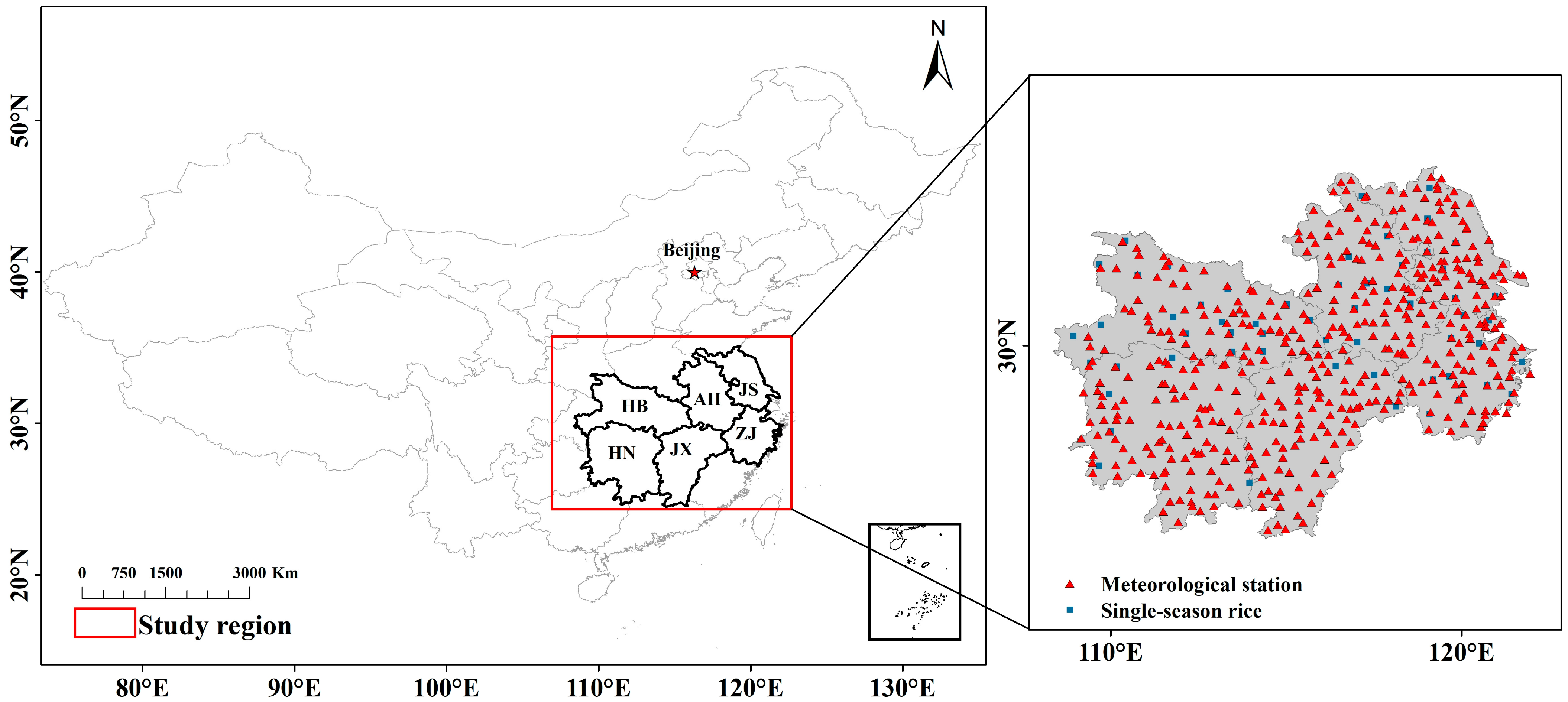
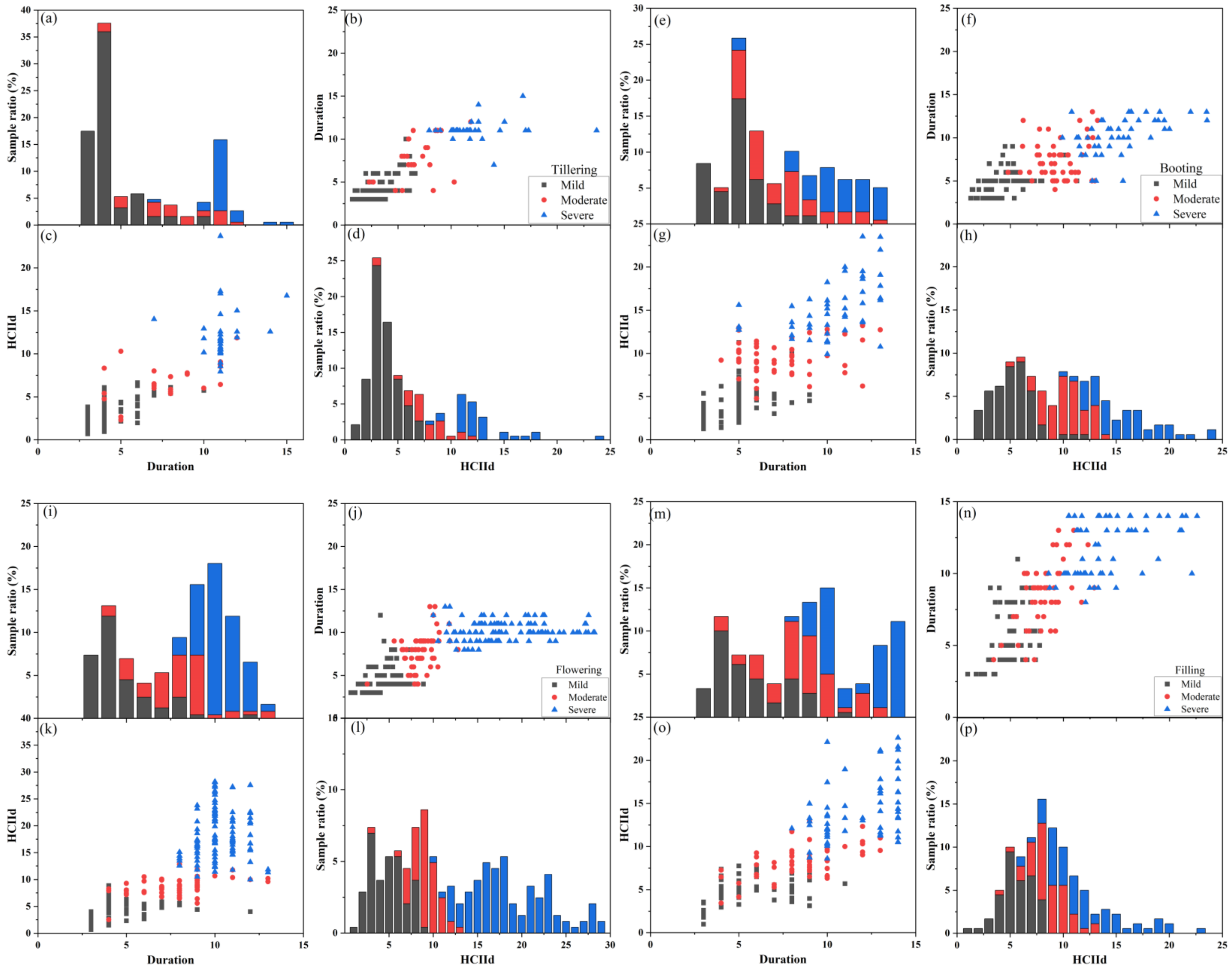
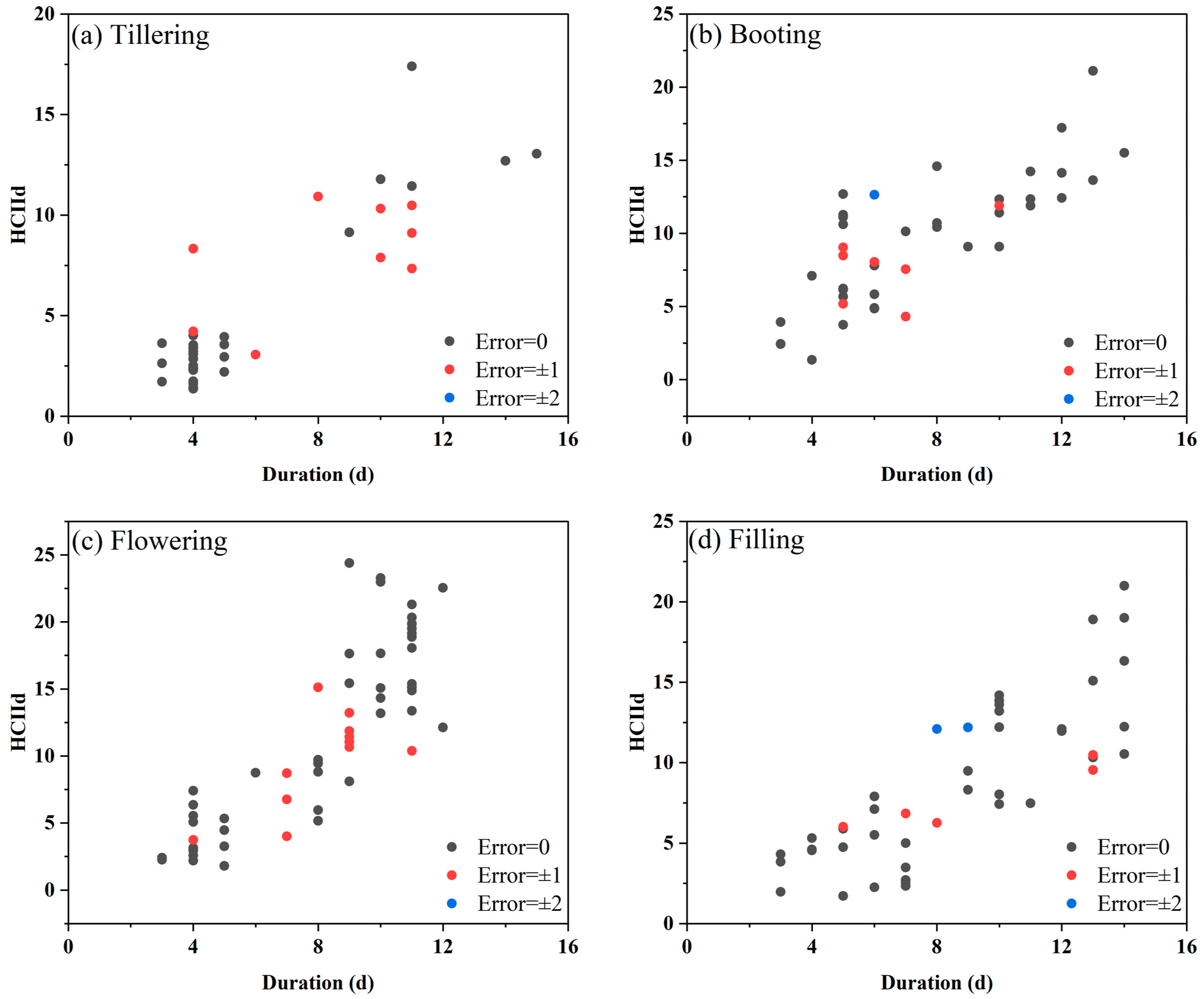
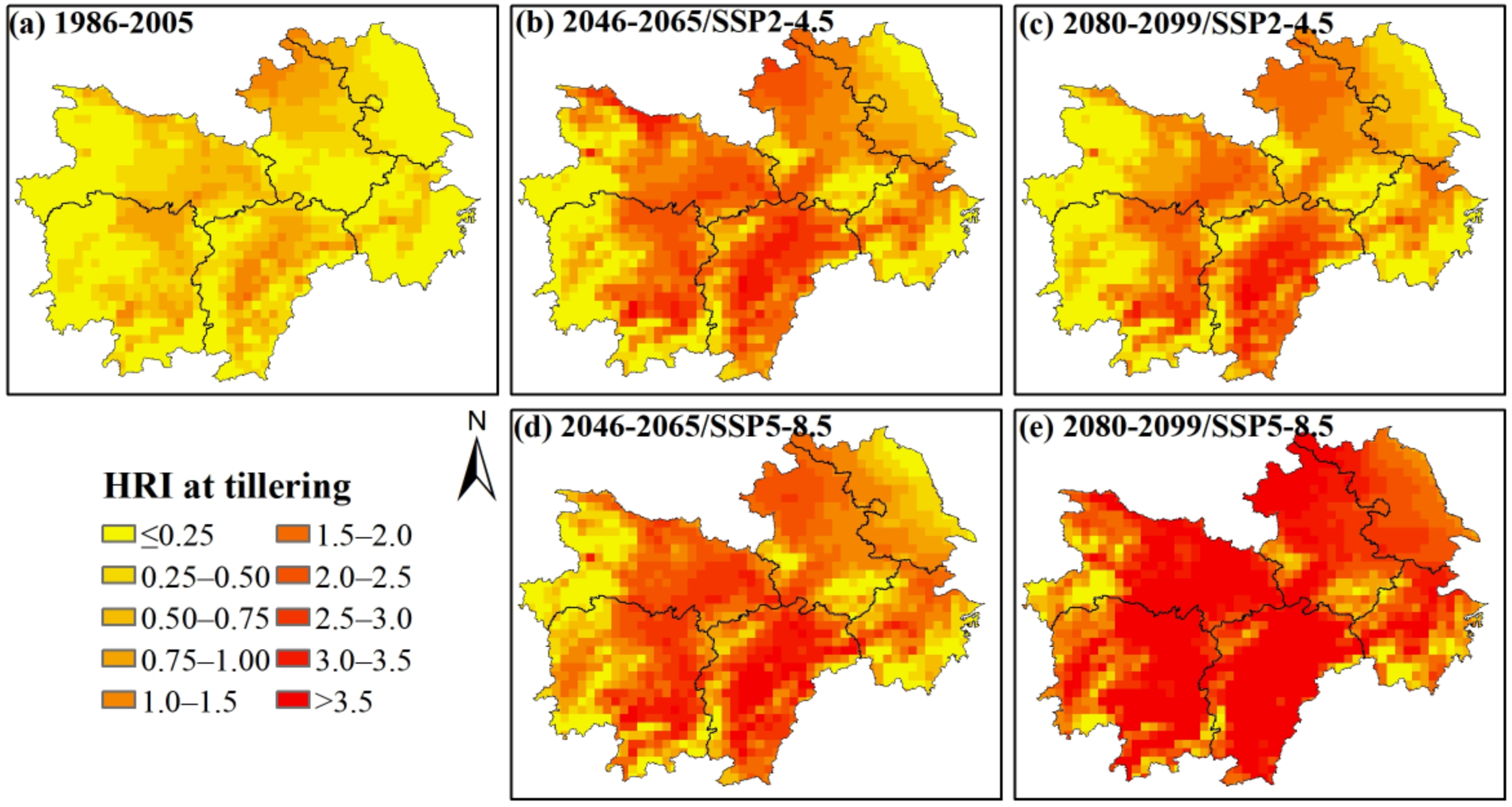

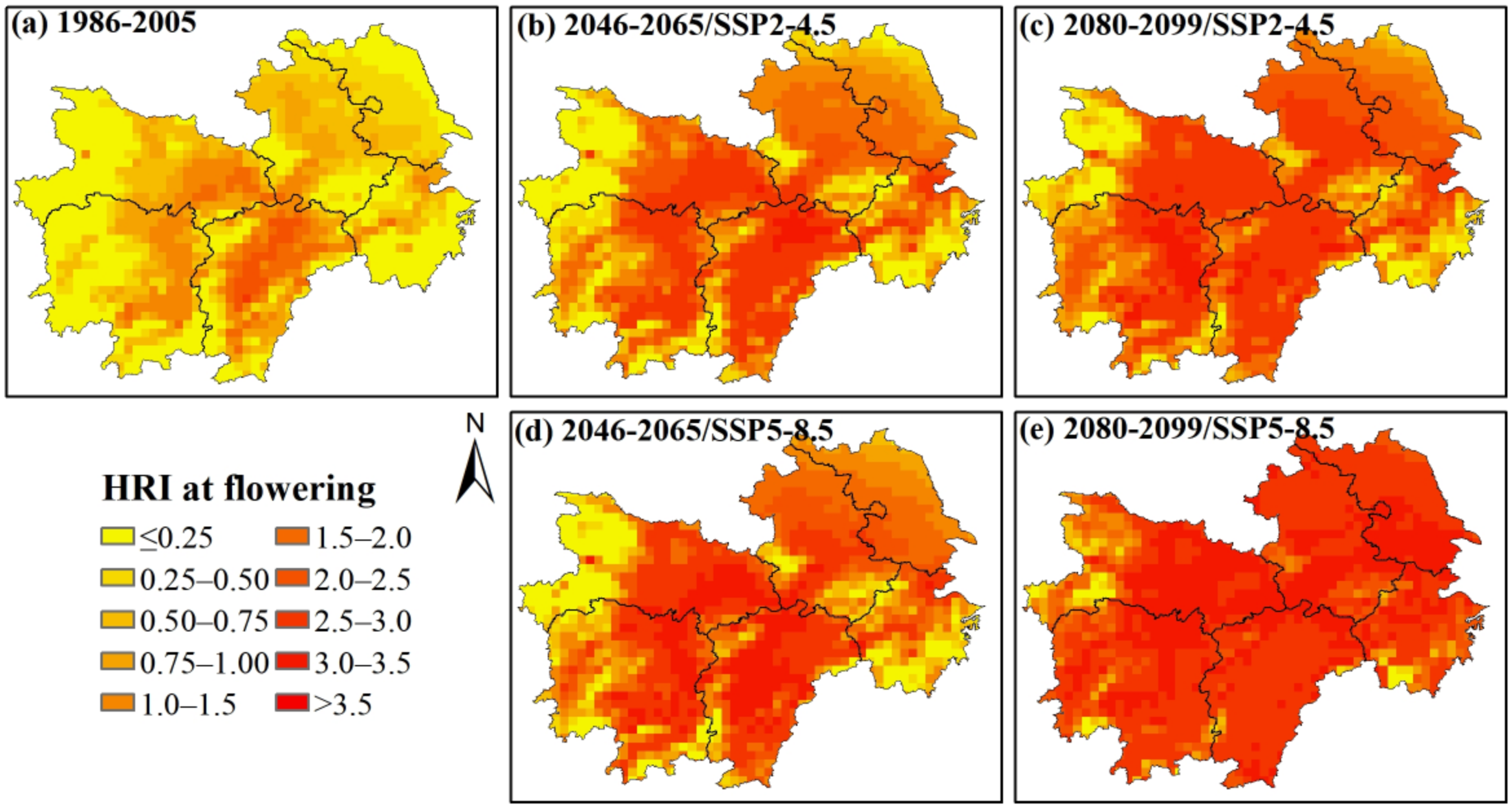
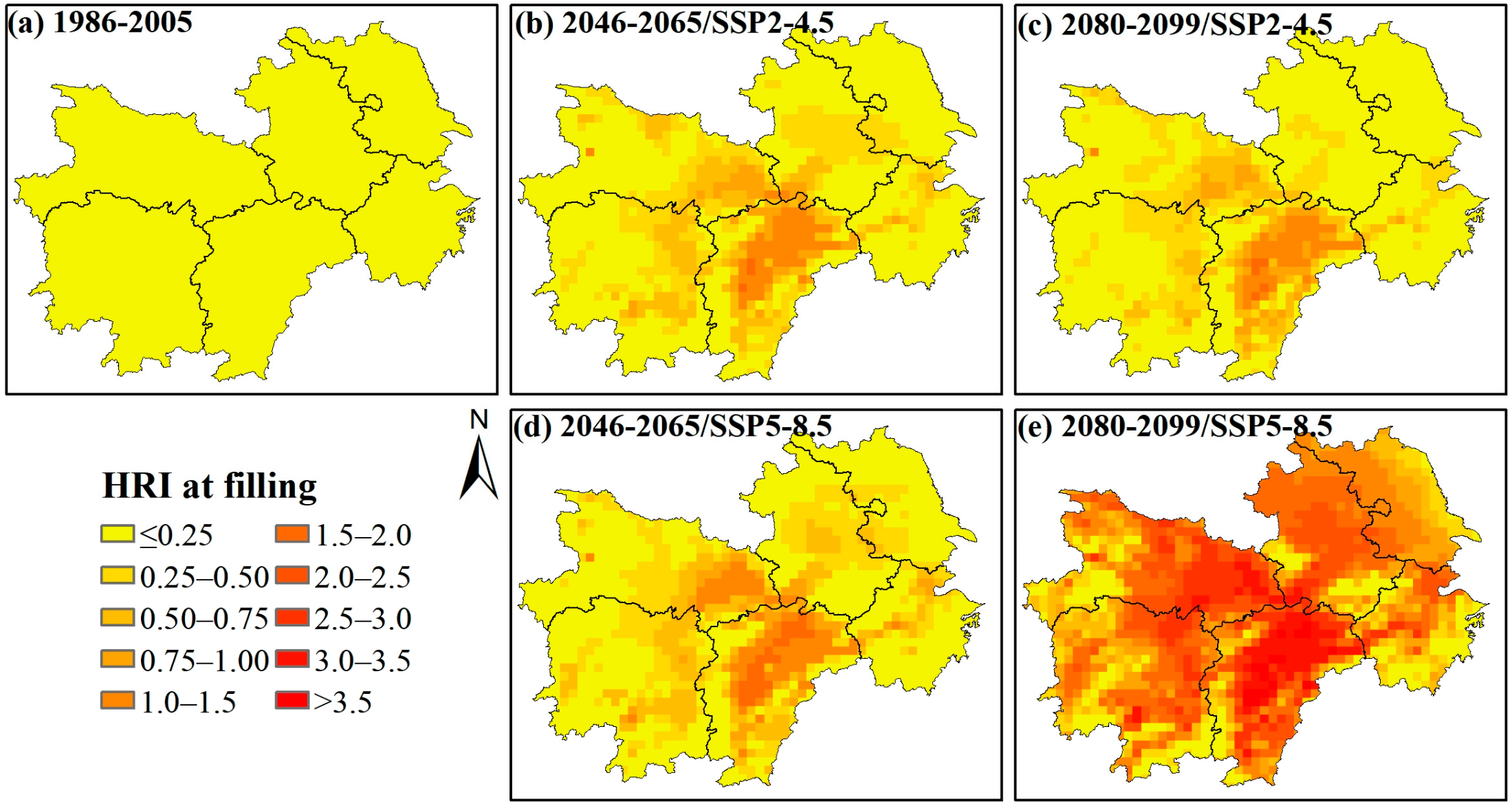
| Model | Institutions and States |
|---|---|
| CanESM5 | Canadian Centre for Climate Modelling and Analysis, Canada |
| FGOALS-g3 | Institute of Atmospheric Physics, Chinese Academy of Sciences, China |
| MRI-ESM2-0 | Meteorological Research Institute, Japan |
| NorESM2-LM | NorESM Climate Modeling Consortium, Norway |
| Growth Stage | Sample Classification | Mild | Moderate | Severe | Total Sample Size |
|---|---|---|---|---|---|
| Tillering | Heat | 127/31 | 27/7 | 35/8 | 235 |
| Non-heat | 415 | ||||
| Booting | Heat | 74/18 | 55/13 | 49/12 | 221 |
| Non-heat | 335 | ||||
| Flowering | Heat | 74/18 | 57/14 | 109/27 | 299 |
| Non-heat | 498 | ||||
| Filling | Heat | 60/18 | 55/12 | 65/16 | 226 |
| Non-heat | 369 |
| Growth Stage | Category | Critical Line | Accuracy | NH-d | H-d |
|---|---|---|---|---|---|
| Tillering | Dry | 92.7% | 36/85.7% | 104/95.4% | |
| Medium | 82.2% | 760/69.7% | 1491/93.8% | ||
| Wet | 80.6% | 711/75.4% | 359/93.4% | ||
| Booting | Dry | 98.8% | 74/100% | 159/98.3% | |
| Medium | 75.1% | 796/69.9% | 1569/78.0% | ||
| Wet | 88.7% | 390/83.8% | 202/100% | ||
| Flowering | Dry | 92.3% | 54/100% | 438/91.4% | |
| Medium | 83.0% | 901/81.8% | 1893/83.6% | ||
| Wet | 82.0% | 1036/77.6% | 345/99.0% | ||
| Filling | Dry | 79.1% | 297/79.4% | 139/78.4% | |
| Medium/wet | 87.0% | 1118/76.0% | 1250/100% |
| Growth Stage | Test Threshold | Mild/Moderate | Moderate/Severe | Classification Performance | |||
|---|---|---|---|---|---|---|---|
| Optimal Range | Optimal Threshold | Optimal Range | Optimal Threshold | Kappa | OA | ||
| Tillering | [3,15] | - | 6 | - | 9 | 0.753 | 0.876 |
| Booting | [3,14] | - | 5 | - | 8 | 0.532 | 0.691 |
| Flowering | [3,13] | - | 5 | - | 8 | 0.647 | 0.779 |
| Filling | [3,14] | - | 6 | - | 9 | 0.564 | 0.711 |
| Growth Stage | Duration | Test Threshold | Mild/Moderate | Moderate/Severe | Classification Performance | |||
|---|---|---|---|---|---|---|---|---|
| Optimal Range | Optimal Threshold | Optimal Range | Optimal Threshold | Kappa | OA | |||
| Tillering | 3~6 d | [0.6,10.3] | [6.7,8.3] | 7.5 | - | - | 0.586 | 0.968 |
| 7~9 d | [5.1,14.1] | - | 6.2 | [8.1,14.0] | 10.05 | 0.627 | 0.789 | |
| ≥10 d | [5.7,23.6] | [5.8,6.0] | 5.9 | [9.1,10.0] | 9.55 | 0.849 | 0.943 | |
| Booting | 3~5 d | [0.8,15.7] | [8.0,8.9] | 8.45 | - | 12.7 | 0.846 | 0.924 |
| 6~8 d | [3.0,15.5] | - | 5.9 | [10.8,11.1] | 10.95 | 0.872 | 0.922 | |
| ≥9 d | [4.5,23.6] | [5.3,6.1] | 5.7 | [9.8,9.9] | 9.8 | 0.662 | 0.877 | |
| Flowering | 3~5 d | [0.6,9.3] | - | 7.4 | - | - | 0.648 | 0.910 |
| 6~8 d | [2.6,15.2] | [5.9,6.4] | 6.15 | [10.6,12.5] | 11.55 | 0.844 | 0.913 | |
| ≥9 d | [4.0,28.3] | [4.5,5.5] | 5.0 | [10.7,11.3] | 11.0 | 0.903 | 0.969 | |
| Filling | 3~6 d | [0.9,9.3] | [5.4,5.5] | 5.4 | - | - | 0.406 | 0.731 |
| 7~9 d | [3.1,15.0] | - | 7.0 | [11.8,12.0] | 11.9 | 0.807 | 0.885 | |
| ≥10 d | [5.6,25.4] | [5.7,6.3] | 6.0 | - | 10.0 | 0.832 | 0.937 | |
| Growth Stage | Duration | Mild | Moderate | Severe |
|---|---|---|---|---|
| Tillering | 3~6 d | [0.6,7.5] | >7.5 | - |
| 7~9 d | [0.6,6.2] | (6.2,10.05] | >10.05 | |
| ≥10 d | [0.6,5.9] | (5.9,9.55] | >9.55 | |
| Booting | 3~5 d | [0.8,8.45] | (8.45,12.7] | >12.7 |
| 6~8 d | [0.8,5.9] | (5.9,10.95] | >10.95 | |
| ≥9 d | [0.8,5.7] | (5.7,9.8] | >9.8 | |
| Flowering | 3~5 d | [0.6,7.4] | >7.4 | - |
| 6~8 d | [0.6,6.15] | (6.15,11.55] | >11.55 | |
| ≥9 d | [0.6,5.0] | (5.0,11.0] | >11.0 | |
| Filling | 3~6 d | [0.9,5.4] | >5.4 | - |
| 7~9 d | [0.9,7.0] | (7.0,11.9] | >11.9 | |
| ≥10 d | [0.9,6.0] | (6.0,10.0] | >10.0 |
Disclaimer/Publisher’s Note: The statements, opinions and data contained in all publications are solely those of the individual author(s) and contributor(s) and not of MDPI and/or the editor(s). MDPI and/or the editor(s) disclaim responsibility for any injury to people or property resulting from any ideas, methods, instructions or products referred to in the content. |
© 2024 by the authors. Licensee MDPI, Basel, Switzerland. This article is an open access article distributed under the terms and conditions of the Creative Commons Attribution (CC BY) license (https://creativecommons.org/licenses/by/4.0/).
Share and Cite
Jiang, M.; Huo, Z.; Zhang, L.; Zhang, F.; Li, M.; Mi, Q.; Kong, R. Dynamic Evaluation and Risk Projection of Heat Exposure Based on Disaster Events for Single-Season Rice along the Middle and Lower Reaches of the Yangtze River, China. Agronomy 2024, 14, 1737. https://doi.org/10.3390/agronomy14081737
Jiang M, Huo Z, Zhang L, Zhang F, Li M, Mi Q, Kong R. Dynamic Evaluation and Risk Projection of Heat Exposure Based on Disaster Events for Single-Season Rice along the Middle and Lower Reaches of the Yangtze River, China. Agronomy. 2024; 14(8):1737. https://doi.org/10.3390/agronomy14081737
Chicago/Turabian StyleJiang, Mengyuan, Zhiguo Huo, Lei Zhang, Fengyin Zhang, Meixuan Li, Qianchuan Mi, and Rui Kong. 2024. "Dynamic Evaluation and Risk Projection of Heat Exposure Based on Disaster Events for Single-Season Rice along the Middle and Lower Reaches of the Yangtze River, China" Agronomy 14, no. 8: 1737. https://doi.org/10.3390/agronomy14081737
APA StyleJiang, M., Huo, Z., Zhang, L., Zhang, F., Li, M., Mi, Q., & Kong, R. (2024). Dynamic Evaluation and Risk Projection of Heat Exposure Based on Disaster Events for Single-Season Rice along the Middle and Lower Reaches of the Yangtze River, China. Agronomy, 14(8), 1737. https://doi.org/10.3390/agronomy14081737






